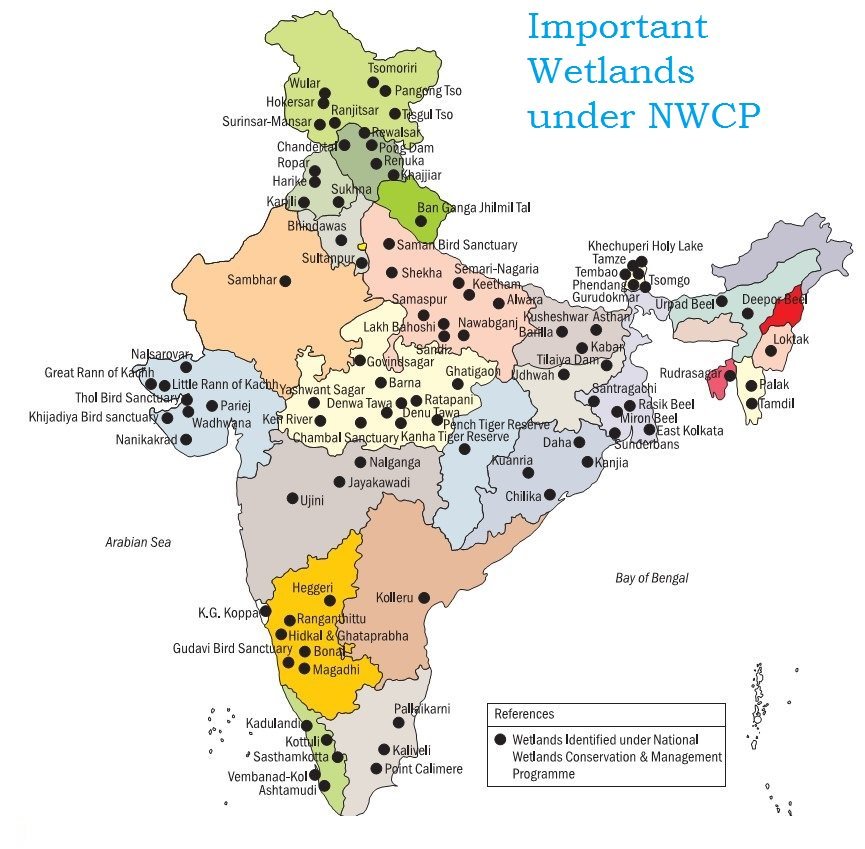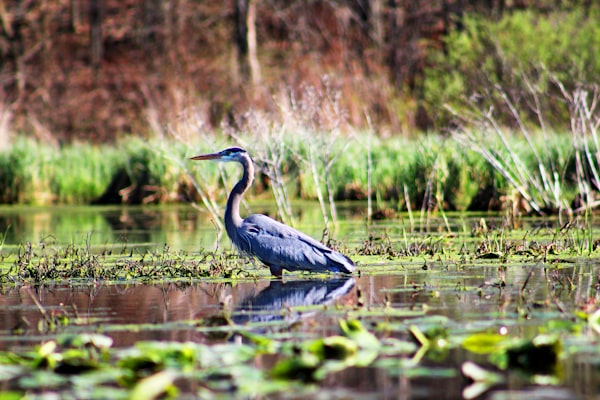Table of contents
Wetlands are vital ecosystems that bridge the gap between terrestrial and aquatic environments.
Definition
Wetlands are defined under the Wetlands (Conservation and Management) Rules, 2017, and the Ramsar Convention.
According to Wetlands Rules, 2017, wetlands are defined as follows:
"Wetlands" means areas of marsh, fen, peatland, or water, whether natural or artificial, permanent or temporary, with water that is static or flowing, fresh, brackish, or salt, including areas of marine water the depth of which at low tide does not exceed six meters but does not include river channels, paddy fields, human-made water bodies/tanks specifically constructed for drinking water purposes, and structures specifically constructed for aquaculture, salt production, and salt pans.
As per the Ramsar Convention:
A wetland is defined as ‘areas of marsh, fen, peatland or water, whether natural or artificial, permanent or temporary, with water that is static or flowing, fresh, brackish or salt, including areas of marine water the depth of which at low tides does not exceed six meters’.
In addition, to protect coherent sites, Article 2.1 of the Convention provides that:
‘Wetlands may include riparian and coastal zones adjacent to the wetlands, and islands or bodies of marine water deeper than six meters at low tide lying within the wetlands.’
Also read: India adds five wetlands to "Ramsar List"
Wetlands in India
India is blessed with a rich diversity of wetlands, totaling over 27,000 in number. These include both inland and coastal wetlands, covering 18.4% of the country's land area. Inland wetlands, which number over 23,000, are particularly important for their role in supporting agriculture, biodiversity, and water resources. Approximately 70% of India's wetlands are used for paddy cultivation.
Types of Wetlands in India

- Human-made wetlands
- These are wetlands built for a purpose, such as storing water for irrigation and drinking, or for producing fish or for recreation.
- Reservoirs, aquaculture ponds, salt pans, dams, barrages, and impoundments are some examples of human-made wetlands.
- Lakes
- Lakes and ponds (also known as lentic systems) are a diverse set of inland freshwater habitats that exist across the globe and provide essential resources and habitats for both terrestrial and aquatic organisms.
- River Floodplains
- These are lands adjacent to river or stream which is subject to periodic inundation by water over-topping the channel.
- Yamuna floodplains are the primary source of water for Delhi.
- Ox-bow Lakes
- Oxbows are formed when the meander of a river is cut off due to silt deposition, or river changing course, isolating a crescent-shaped waterbody.
- The basins of Ganga and Brahmaputra rivers abound in oxbows. In Mahanadi Delta, Ansupa is an oxbow located at delta apex.
- Marshes
- These are dominated by herbaceous plants and are sustained by water sources other than direct rainfall like surface runoff, groundwater or tidal flow.
- Kanwar Jheel (Kabar Tal) is a marsh located in floodplains of Burhi Gandak in Bihar.
- Estuaries
- An estuary is a partially enclosed coastal body of brackish water with one or more rivers or streams flowing into it, and with a free connection to the open sea.
- Estuaries form a transition zone between river and maritime environments.
- A coastal lagoon is a bar-built estuary, formed when offshore barrier sand islands develop above sea-level and extend in a chain, broken by one or more inlets.
- Chilika is a lagoon in Odisha separated from the Bay of Bengal by a long sand berm.
- Swamps
- Swamps are wetlands dominated by trees.
- These have poor drainage and sufficient water supply to keep the ground waterlogged, and level of minerals to stimulate decay of organisms and prevent accumulation of organic materials.
- Mangroves are coastal swamps bordering major deltas of the country.
- Sunderbans, spread across India and Bangladesh is the world’s largest single contiguous mangrove swamp.
Key Characteristics of Wetlands
- Hydrophytic Vegetation: Wetlands are home to plants adapted to waterlogged soil, known as hydrophytes. These plants thrive in conditions with limited oxygen, contributing to the unique wetland ecosystem.
- Hydric Soils: Wetlands often have hydric soils, characterized by poor drainage and low oxygen levels. These soils support the growth of wetland vegetation and are a defining feature of these ecosystems.
- Periodic Flooding: Wetlands experience periodic flooding from nearby water bodies. This flooding is essential for their ecological health and supports species specially adapted to these conditions.
We can't clear UPSC for you.
But with our personalised mentor support, you'll be ready to do it yourself.
Importance of Wetlands
- Diverse benefits: Wetlands provide a wide range of ecosystem services, from basic necessities like freshwater supply and food to more complex functions like flood control and climate change mitigation.
- Biodiversity haven: Wetlands are essential habitats for a variety of plants and animals, including aquatic species, native birds, and migratory birds.
- Sustainable tourism: Wetlands can be important destinations for sustainable tourism, providing opportunities for recreation and education while supporting local communities.
- Water purification: Wetlands act as natural filters, removing pollutants and sediments from water, thereby improving water quality.
- Climate and flood control: They play a crucial role in regulating water flow, preventing floods, and stabilizing local climates.
- Shoreline protection: Wetlands act as buffers against erosion and protect shorelines from harmful pollutants.
- Genetic reservoirs: They can be valuable sources of genetic diversity for various plant species, including rice.
Conservation of Wetlands in India
The conservation of wetlands is crucial for maintaining ecological balance and sustaining livelihoods.
Several efforts have been made to protect and preserve these vital ecosystems in India:
- Ramsar Convention: India is a signatory to the Ramsar Convention on Wetlands, an international treaty dedicated to the conservation and sustainable use of wetlands. The convention promotes the wise use of wetlands and designates specific sites as Wetlands of International Importance (Ramsar Sites).

- National Wetlands Conservation Programme (NWCP): Launched in 1985-86, NWCP identifies and conserves critical wetland areas in India. It provides financial and technical assistance to state governments for wetland management and conservation.

- Wetlands Rules, 2017: India has established regulations under the Wetlands (Conservation and Management) Rules, 2017, which delegate the identification and protection of wetlands to state authorities. These rules aim to balance development with wetland preservation.
- Montreux Record: Some wetlands in India, such as Keoladeo National Park and Loktak Lake, are listed in the Montreux Record, signifying that they require special attention due to changes in their ecological character.
- Local and Community Involvement: Encouraging local communities to actively participate in wetland conservation efforts is essential. Their knowledge and support are invaluable for the sustained protection of these ecosystems.
- Research and Education: Promoting research and education on wetlands' ecological importance and threats they face can lead to informed conservation efforts and greater public awareness.
Challenges and Future Perspectives
- Despite conservation efforts, wetlands in India face various threats, including urbanization, agriculture, pollution, climate change, and invasive species.
- Addressing these challenges requires concerted action from government bodies, NGOs, communities, and individuals.
- Wetlands play a critical role in maintaining biodiversity, providing ecosystem services, and supporting sustainable livelihoods.
- Conserving these unique ecosystems is not just an environmental imperative but also essential for ensuring a harmonious balance between human activities and nature.
Wetlands are not just guardians of biodiversity but also the key to a sustainable and resilient future.
Previous Post